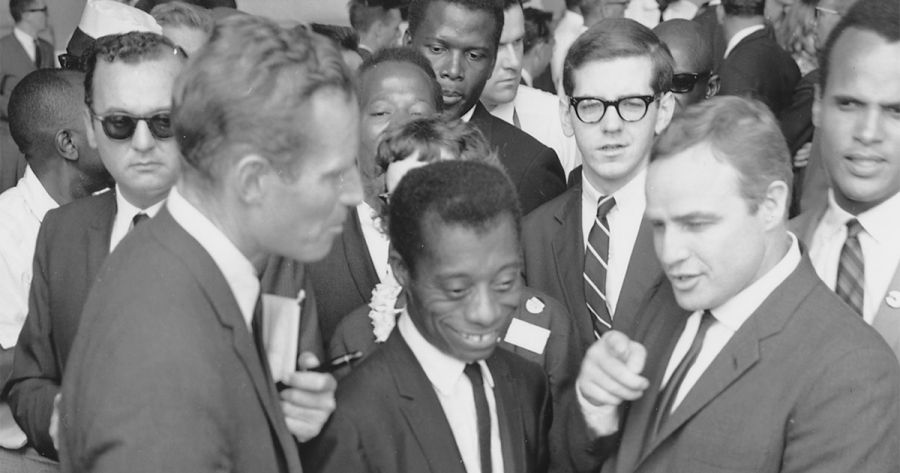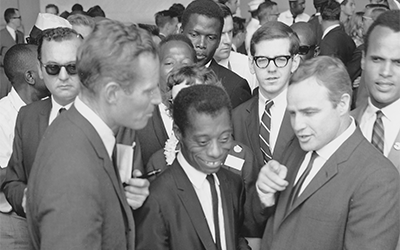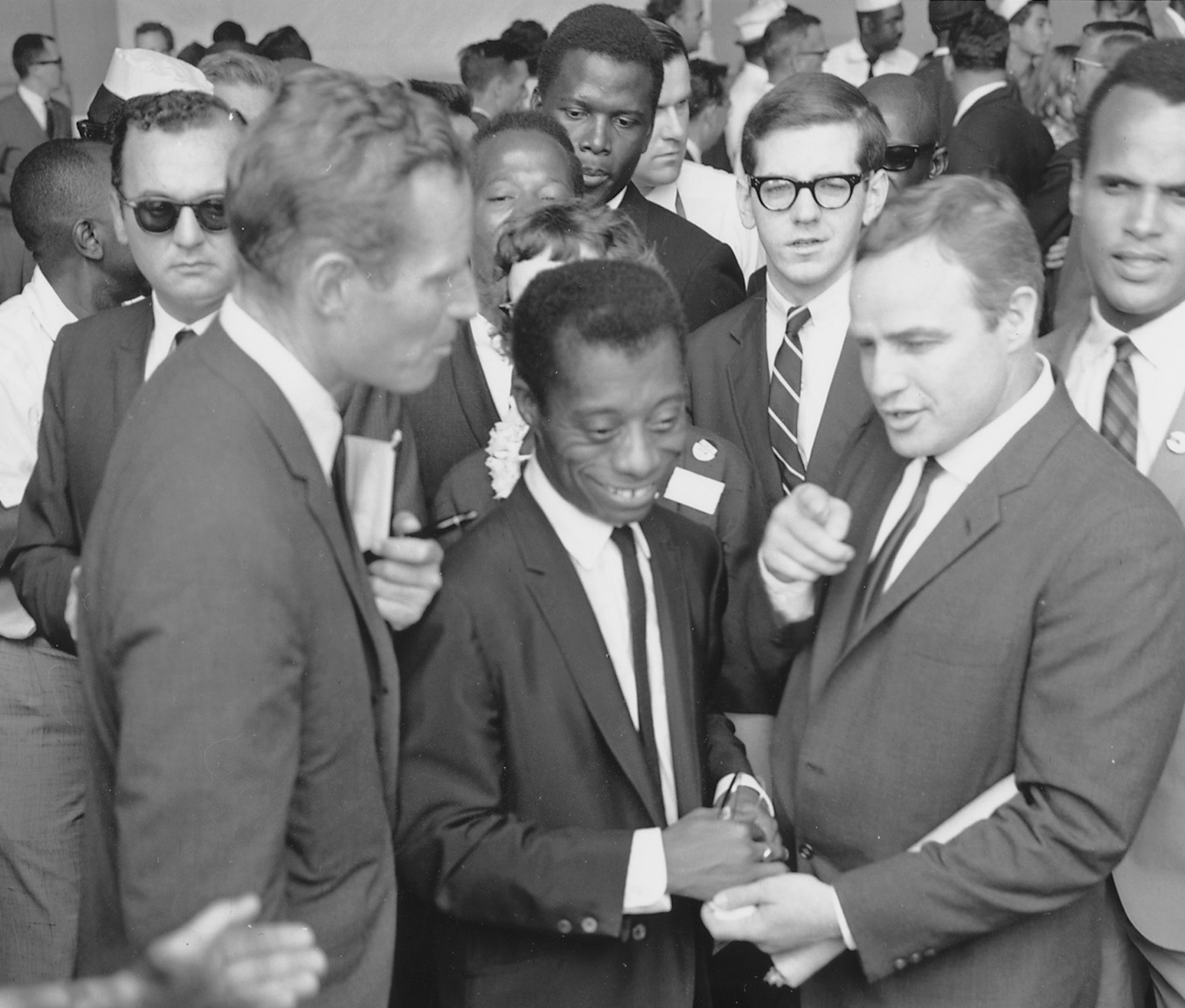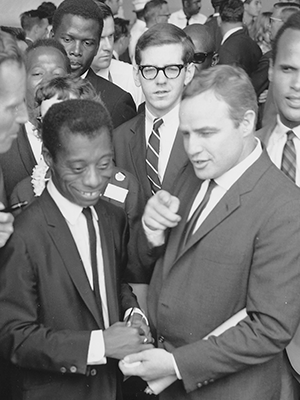
- Free Article: No
- Contents Category: Commentary
- Custom Article Title: James Baldwin this time: The centenary of an indispensable prophet
- Review Article: No
- Article Title: James Baldwin this time
- Article Subtitle: The centenary of an indispensable prophet
- Online Only: No
- Custom Highlight Text:
In 1903 W.E.B. Du Bois famously declared: ‘The problem of the twentieth century is the problem of the color-line.’ He meant not only in the United States but also elsewhere in the world. As for this century, in America, at least, we can now say it remains the dominant problem. The very fact, for instance, of a movement named ‘Black Lives Matter’ – now a decade old – speaks to something unspeakable: an obvious and overt racism that is driving America to a reckoning.
- Featured Image (400px * 250px):

- Alt Tag (Featured Image): ‘James Baldwin this time: The centenary of an indispensable prophet’ by Paul Kane
There is very nearly a consensus that Baldwin is among America’s finest essayists, but he stands alone as the most despairing and bitter. And yet that is not the counsel he urges. He is not one of Job’s ‘comforters’; he is, as he puts it, a Jeremiah, whose aim is a New Jerusalem.
 Charlton Heston, James Baldwin and Marlon Brando at the Civil Rights March in Washington DC (National Archives at College Park, Public Domain, via Wikimedia Commons)
Charlton Heston, James Baldwin and Marlon Brando at the Civil Rights March in Washington DC (National Archives at College Park, Public Domain, via Wikimedia Commons)
The procession of numerous centennial events this year, in the United States and in France (where he lived most of his life), raises two questions: what is his standing or reputation now? And can we discern his legacy from our current vantage point? These are big questions, but they are worth considering even in cursory fashion.
Although he didn’t publish his first book until he was twenty-nine, Baldwin published twenty-two books and almost 100 essays and reviews by the time he died at the age of sixty-three in 1987. By the early 1960s he was already famous, and in 1963 he appeared on the cover of Time magazine. He was also popular with the FBI, which compiled a file on him of more than 1,800 pages (he was considered a dangerous revolutionary). His was a rapid rise, followed by a precipitous decline during the next decade. An article by a young Henry Louis Gates Jr in 1973 was rejected by Time magazine because Baldwin had become – in the intervening ten years – ‘passé’. More wounding, though, considering Baldwin’s deep engagement with the civil rights movement in the 1960s, were the vicious criticisms by Eldridge Cleaver and other Black Power and Black Arts leaders, who saw Baldwin as not only passé but as insufficiently radical and shamefully ‘sycophantic’ towards whites. More telling, perhaps, were the homophobic remarks about his supposed lack of black masculinity, whereby Baldwin, as gay, was attempting to become a ‘white man in a black body’.
By the 1980s, Baldwin ruefully accepted his diminished fame (while at the same time becoming more markedly militant, and even strident, in his rhetoric: ‘in a couple of days, blacks may be using the vote to outwit the Final Solution, Yes. The Final Solution’). Not long after his death, there was a revival of interest and admiration, to the point that there is now a fully fledged James Baldwin industry of academic articles and monographs, as well as an increasing Baldwin presence in popular culture. In addition to three contemporaneous films about him, there have been two major documentaries, The Price of the Ticket (1989) and the award-winning I Am Not Your Negro (2016), with a major biopic, starring Bill Porter as Baldwin, currently in production. In 2018, Barry Jenkins adapted the late novel If Beale Street Could Talk (1974) into a successful film, which had the salutary consequence of introducing Baldwin to a new generation of readers.
As a stage and television character, Baldwin is also in evidence: He appears in James Graham’s play Best of Enemies as friend and adviser to Gore Vidal, and, more recently, in episode five of the television series Feud: Capote vs the Swans (Binge), where he comforts and admonishes Truman Capote. Both cameos are entirely fictional, but that’s all the more indicative of his new celebrity status. We have moved from history to myth. This would not sit well with Baldwin, were he with us today. Aside from grasping the fleeting nature of fame, he was clear about its corrosive effect:
It’s difficult to be a legend. It’s hard for me to recognize me. You spend a lot of time trying to avoid it. It’s really something, to be a legend, unbearable. The way the world treats you is unbearable, and especially if you’re black. It’s unbearable because time is passing and you are not your legend, but you’re trapped in it. (Interview with Quincy Troupe, 1987)
Part of that legend included a developing narrative of artistic diminishment: in the wake of the assassinations of black leaders he had befriended (the trio of ‘Medgar, Martin and Malcolm’, as he put it), Baldwin – it’s asserted – withdrew and never regained the power of his rhetorical genius or the imaginative reach of his fiction. He was a disappointment; he did not fulfil his promise as a writer. But when one looks more closely at the various critiques, from the 1960s to the present, it is noticeable that such evaluations are often based on shifting notions of aesthetic value and political exigency. We know that reputations often rise and fall and then rise again. What’s interesting now in Baldwin studies is not the attempt to sum him up but to use him, to put him to work in different contexts and for different ends. He has been woven into the fabric of contemporary American culture. He is, in a word, canonical.
There is something mercurial in James Baldwin which seems central to his writing. At the level of style, he frequently surprises with abrupt turns or turnings back, not unlike what we experience in the essays of Joseph Brodsky, especially when there is an ironic reflection that seems to open up a void beneath the sentence. In ‘Notes of a Native Son’, Baldwin recalls how on the day of his father’s funeral a race riot broke out in Harlem: ‘I had declined to believe in that apocalypse which had been central to my father’s vision [as a preacher]: very well, life seemed to be saying, here is something that will certainly pass for an apocalypse until the real thing comes along.’ That archness is pure Baldwin. At the same time, you can discern influences, including the psychological subtlety of Henry James; the rhythms and diction of Harlem and the blues; the cadences of the Bible and the gospel hymns he grew up with. There is a protean quality to Baldwin’s prose. It is richest in his fiction, where he can ride the language like a surfer, as if catching waves of pulsing life.
At the level of ideas in his non-fiction, and of character in his stories and novels, this mutability suggests a deeper source, something that cannot be caught or held in a linear grid of meaning. One of the difficulties in apprehending Baldwin is how prolific and varied he is: 6,895 pages of material in multiple genres: essays, novels, stories, plays, poems, reviews, interviews, articles, commentaries. Evaluations of him are almost always focused on one or two genres. His quicksilver versatility might be traceable to his status as a double exile: a black man in a white society; and a gay man in the hypermasculine culture of the 1940s and 1950s. Not only is he alienated from white America, he is often an alien to the larger black community for being ‘queer’ and an aesthete. It’s no wonder he had to leave America, for Paris, to write about America.
Baldwin, it’s worth noting, did not consider himself homosexual, but androgynous (like everyone else: ‘there is a man in every woman and a woman in every man,’ he argues). His notion of gender fluidity is likely to resonate in our contemporary world in a way that is wanting in many of his peers (Norman Mailer, William Styron, Philip Roth, even Truman Capote). It is also analogous to his fluctuating use of pronouns and identities. His deployment of we, especially, can alter according to his sense of audience. It can refer to his identity as an American or an American black, when speaking to whites; it can indicate his identification with fellow blacks exclusively, or to fellow artists. But there are times, as in ‘Many Thousands Gone’, when he is so focused on conveying a thought or situation to a white American readership that he will slip into using ‘we’ for emphasis, as if he too was a white man: ‘Time has made some changes in the Negro face. Nothing has succeeded in making it exactly like our own’ (emphasis added). That startling shape shifting is indicative of how far Baldwin will go to get under our skin. And there’s a reason for this: it serves a purpose.
Baldwin’s second book, Giovanni’s Room (1956), a gay novel set in France, is narrated by a white man, David; there are no black characters. If Beale Street Could Talk, a late novel, is a love story about two black childhood friends who get married; it is narrated by the woman, Tish. ‘Going to Meet the Man’, the eponymous story of his short story collection (1965), employs free indirect discourse from the point of view of a white bigoted deputy sheriff in the South. These are three examples of the way Baldwin refuses to be pinned down or boxed in. Because he saw himself primarily as a witness to what was happening in his world, he felt free to find the best vantage point from which to view it and report it. And early on, what he saw was violence, injustice, and fear, but also courage, forbearance, and tenderness.
For all the anger and even hatred that animates his work, Baldwin insisted that the only way forward, the only way out, was through a renovation of the self, and this could only be accomplished through deep communication and empathy. In the introduction to Nobody Knows My Name (1961), Baldwin says, ‘my own experience proves to me that the connection between American whites and blacks is far deeper and more passionate than any of us like to think’:
The questions which one asks oneself begin, at last, to illuminate the world, and become one’s key to the experience of others. One can only face in others what one can face in oneself. On this confrontation depends the measure of our wisdom and compassion. This energy is all that one finds in the rubble of vanished civilizations, and the only hope for ours.
That James Baldwin should have preached a gospel of love is a continuous surprise, but in this time of moral panic in America, he remains an indispensable prophet.
This article is one of a series of ABR commentaries on cultural and political subjects being funded by the Copyright Agency’s Cultural Fund.



Comments powered by CComment